Exploring Reserves and Dividends in Corporate Accounting Practices
VerifiedAdded on 2023/04/23
|8
|1423
|495
Essay
AI Summary
This essay provides a detailed overview of corporate accounting, focusing on reserves, retained earnings, and dividends. It explains the different types of reserves, including general and specific reserves, and their uses in meeting contingencies, purchasing assets, and paying debts. The role of retained earnings in reinvesting profits back into the business is examined, along with the impact of dividend policies on shareholder value. The essay also discusses the movements of accounts in the reserve account, including dividend payments and the handling of profits or losses, referencing AASB 101 guidelines. The analysis concludes by highlighting the importance of establishing clear dividend policies and maintaining adequate reserves for long-term financial stability.
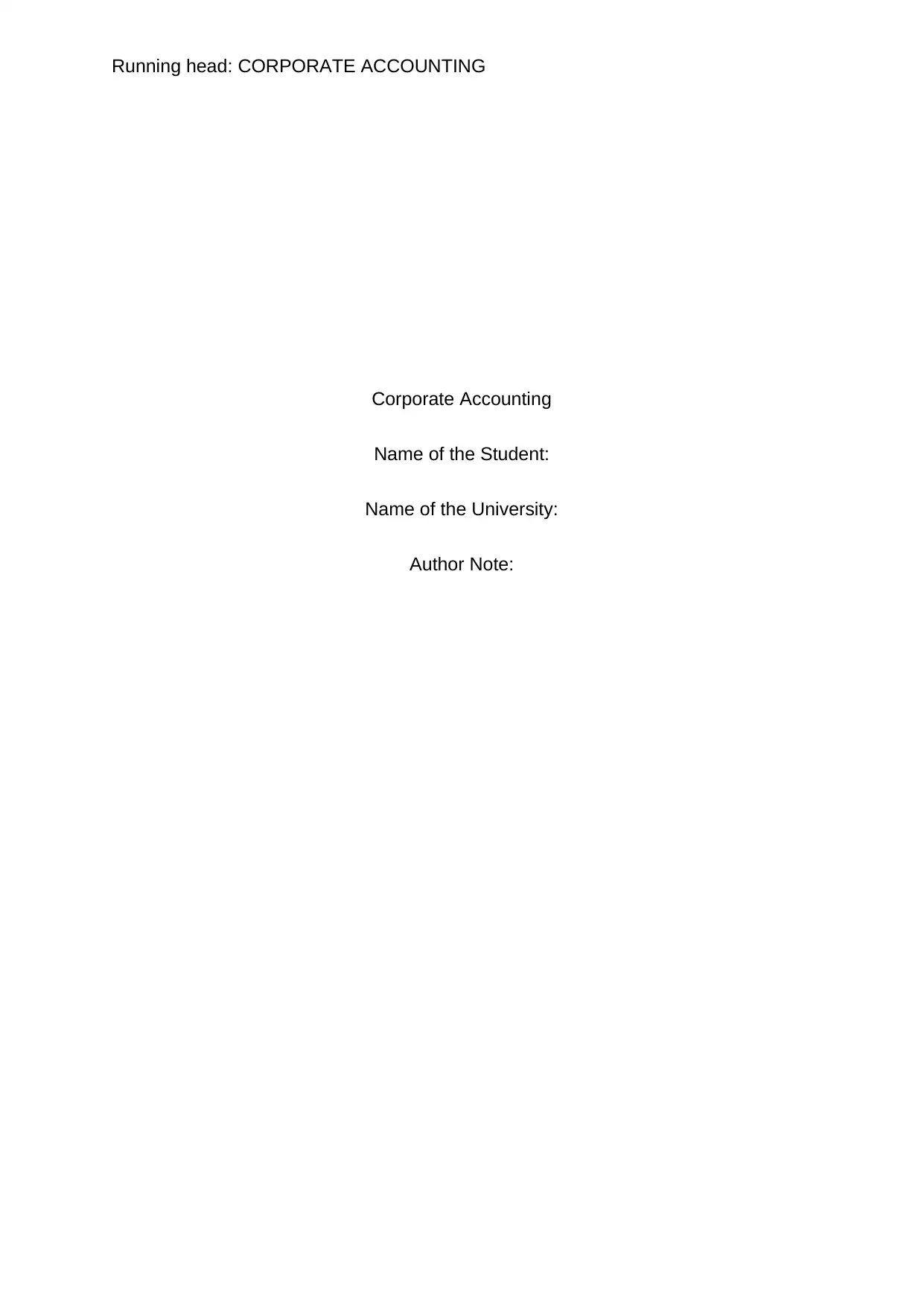
Running head: CORPORATE ACCOUNTING
Corporate Accounting
Name of the Student:
Name of the University:
Author Note:
Corporate Accounting
Name of the Student:
Name of the University:
Author Note:
Paraphrase This Document
Need a fresh take? Get an instant paraphrase of this document with our AI Paraphraser
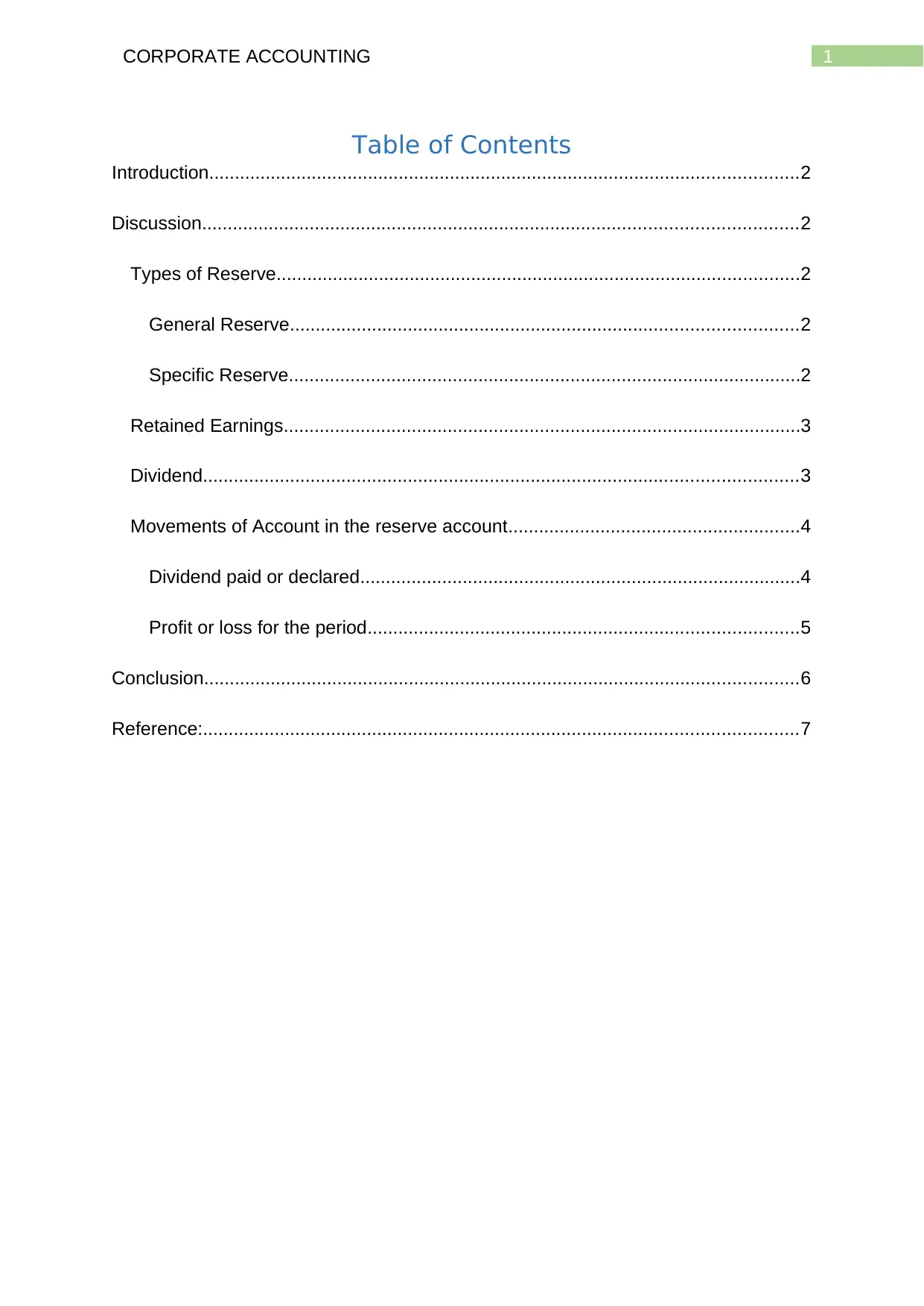
1CORPORATE ACCOUNTING
Table of Contents
Introduction...................................................................................................................2
Discussion....................................................................................................................2
Types of Reserve......................................................................................................2
General Reserve...................................................................................................2
Specific Reserve....................................................................................................2
Retained Earnings.....................................................................................................3
Dividend....................................................................................................................3
Movements of Account in the reserve account.........................................................4
Dividend paid or declared......................................................................................4
Profit or loss for the period....................................................................................5
Conclusion....................................................................................................................6
Reference:....................................................................................................................7
Table of Contents
Introduction...................................................................................................................2
Discussion....................................................................................................................2
Types of Reserve......................................................................................................2
General Reserve...................................................................................................2
Specific Reserve....................................................................................................2
Retained Earnings.....................................................................................................3
Dividend....................................................................................................................3
Movements of Account in the reserve account.........................................................4
Dividend paid or declared......................................................................................4
Profit or loss for the period....................................................................................5
Conclusion....................................................................................................................6
Reference:....................................................................................................................7
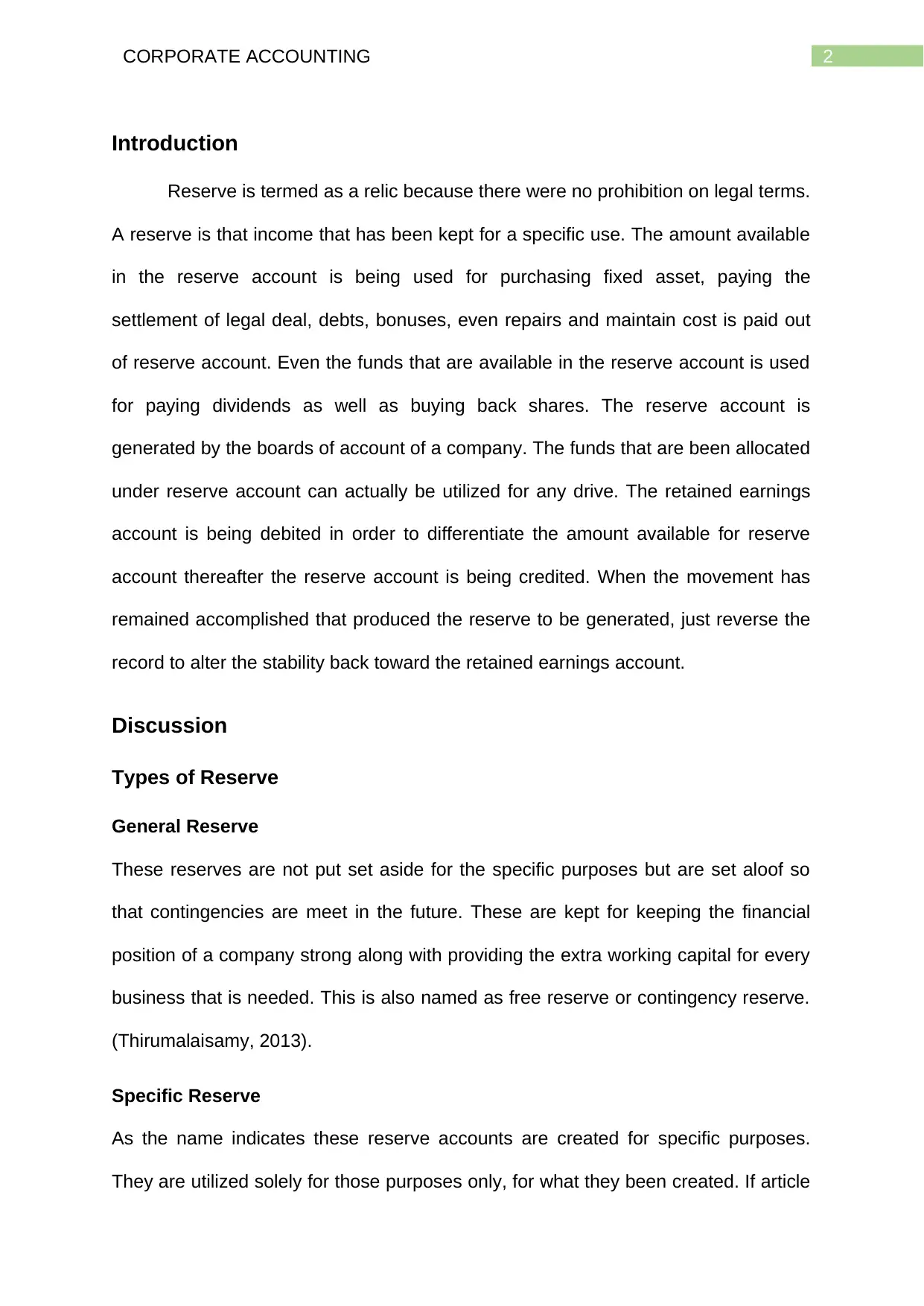
2CORPORATE ACCOUNTING
Introduction
Reserve is termed as a relic because there were no prohibition on legal terms.
A reserve is that income that has been kept for a specific use. The amount available
in the reserve account is being used for purchasing fixed asset, paying the
settlement of legal deal, debts, bonuses, even repairs and maintain cost is paid out
of reserve account. Even the funds that are available in the reserve account is used
for paying dividends as well as buying back shares. The reserve account is
generated by the boards of account of a company. The funds that are been allocated
under reserve account can actually be utilized for any drive. The retained earnings
account is being debited in order to differentiate the amount available for reserve
account thereafter the reserve account is being credited. When the movement has
remained accomplished that produced the reserve to be generated, just reverse the
record to alter the stability back toward the retained earnings account.
Discussion
Types of Reserve
General Reserve
These reserves are not put set aside for the specific purposes but are set aloof so
that contingencies are meet in the future. These are kept for keeping the financial
position of a company strong along with providing the extra working capital for every
business that is needed. This is also named as free reserve or contingency reserve.
(Thirumalaisamy, 2013).
Specific Reserve
As the name indicates these reserve accounts are created for specific purposes.
They are utilized solely for those purposes only, for what they been created. If article
Introduction
Reserve is termed as a relic because there were no prohibition on legal terms.
A reserve is that income that has been kept for a specific use. The amount available
in the reserve account is being used for purchasing fixed asset, paying the
settlement of legal deal, debts, bonuses, even repairs and maintain cost is paid out
of reserve account. Even the funds that are available in the reserve account is used
for paying dividends as well as buying back shares. The reserve account is
generated by the boards of account of a company. The funds that are been allocated
under reserve account can actually be utilized for any drive. The retained earnings
account is being debited in order to differentiate the amount available for reserve
account thereafter the reserve account is being credited. When the movement has
remained accomplished that produced the reserve to be generated, just reverse the
record to alter the stability back toward the retained earnings account.
Discussion
Types of Reserve
General Reserve
These reserves are not put set aside for the specific purposes but are set aloof so
that contingencies are meet in the future. These are kept for keeping the financial
position of a company strong along with providing the extra working capital for every
business that is needed. This is also named as free reserve or contingency reserve.
(Thirumalaisamy, 2013).
Specific Reserve
As the name indicates these reserve accounts are created for specific purposes.
They are utilized solely for those purposes only, for what they been created. If article
⊘ This is a preview!⊘
Do you want full access?
Subscribe today to unlock all pages.

Trusted by 1+ million students worldwide
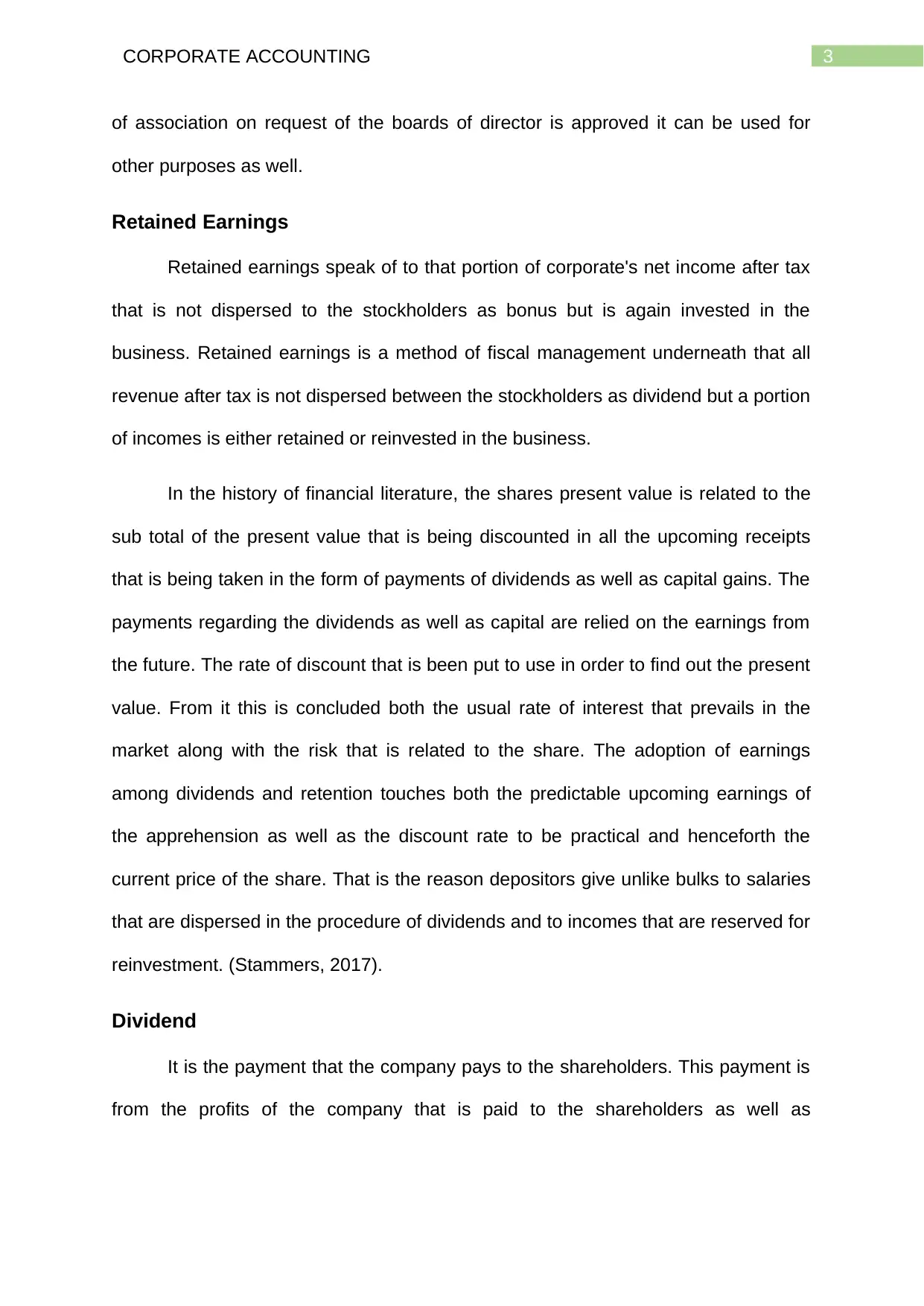
3CORPORATE ACCOUNTING
of association on request of the boards of director is approved it can be used for
other purposes as well.
Retained Earnings
Retained earnings speak of to that portion of corporate's net income after tax
that is not dispersed to the stockholders as bonus but is again invested in the
business. Retained earnings is a method of fiscal management underneath that all
revenue after tax is not dispersed between the stockholders as dividend but a portion
of incomes is either retained or reinvested in the business.
In the history of financial literature, the shares present value is related to the
sub total of the present value that is being discounted in all the upcoming receipts
that is being taken in the form of payments of dividends as well as capital gains. The
payments regarding the dividends as well as capital are relied on the earnings from
the future. The rate of discount that is been put to use in order to find out the present
value. From it this is concluded both the usual rate of interest that prevails in the
market along with the risk that is related to the share. The adoption of earnings
among dividends and retention touches both the predictable upcoming earnings of
the apprehension as well as the discount rate to be practical and henceforth the
current price of the share. That is the reason depositors give unlike bulks to salaries
that are dispersed in the procedure of dividends and to incomes that are reserved for
reinvestment. (Stammers, 2017).
Dividend
It is the payment that the company pays to the shareholders. This payment is
from the profits of the company that is paid to the shareholders as well as
of association on request of the boards of director is approved it can be used for
other purposes as well.
Retained Earnings
Retained earnings speak of to that portion of corporate's net income after tax
that is not dispersed to the stockholders as bonus but is again invested in the
business. Retained earnings is a method of fiscal management underneath that all
revenue after tax is not dispersed between the stockholders as dividend but a portion
of incomes is either retained or reinvested in the business.
In the history of financial literature, the shares present value is related to the
sub total of the present value that is being discounted in all the upcoming receipts
that is being taken in the form of payments of dividends as well as capital gains. The
payments regarding the dividends as well as capital are relied on the earnings from
the future. The rate of discount that is been put to use in order to find out the present
value. From it this is concluded both the usual rate of interest that prevails in the
market along with the risk that is related to the share. The adoption of earnings
among dividends and retention touches both the predictable upcoming earnings of
the apprehension as well as the discount rate to be practical and henceforth the
current price of the share. That is the reason depositors give unlike bulks to salaries
that are dispersed in the procedure of dividends and to incomes that are reserved for
reinvestment. (Stammers, 2017).
Dividend
It is the payment that the company pays to the shareholders. This payment is
from the profits of the company that is paid to the shareholders as well as
Paraphrase This Document
Need a fresh take? Get an instant paraphrase of this document with our AI Paraphraser
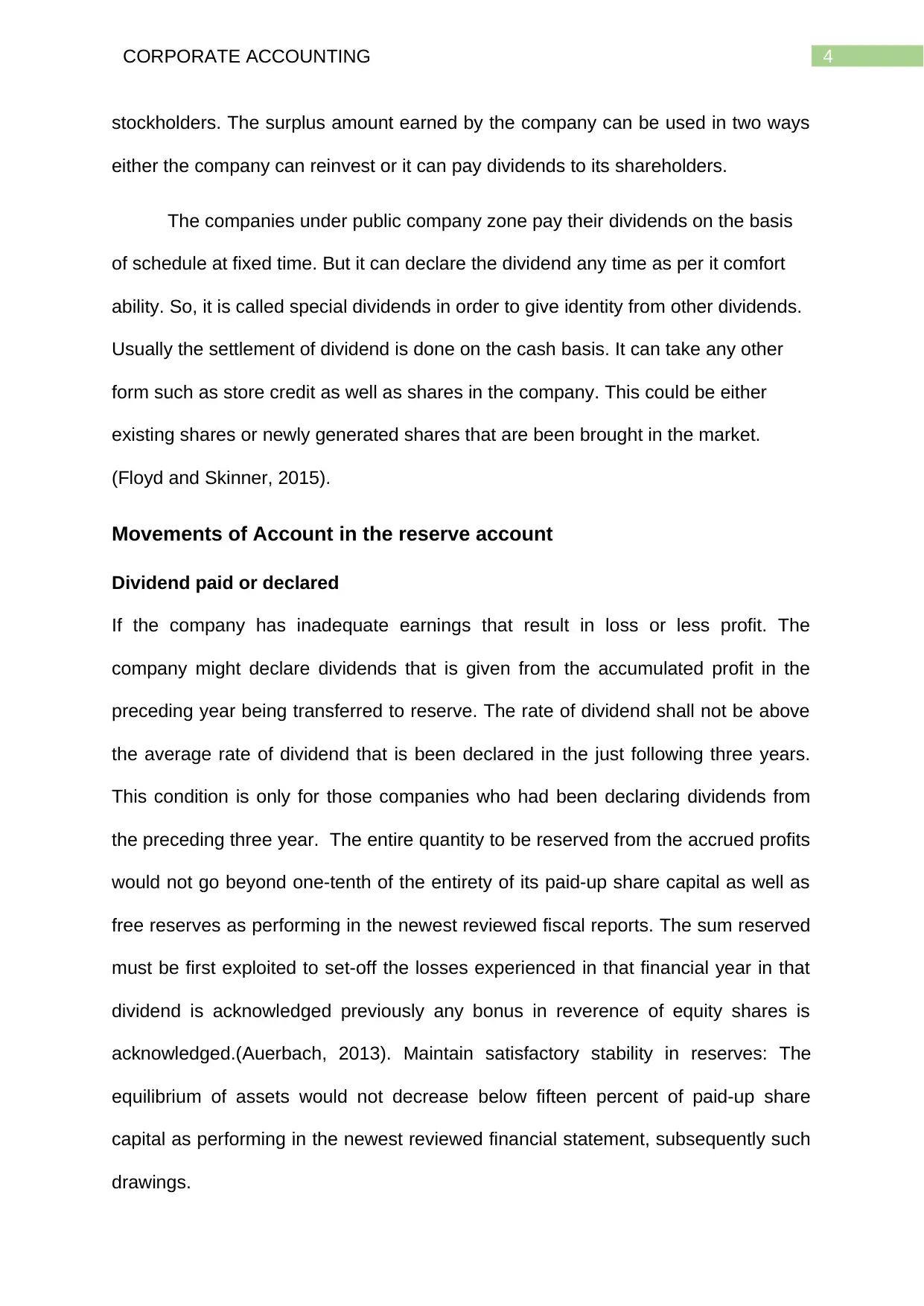
4CORPORATE ACCOUNTING
stockholders. The surplus amount earned by the company can be used in two ways
either the company can reinvest or it can pay dividends to its shareholders.
The companies under public company zone pay their dividends on the basis
of schedule at fixed time. But it can declare the dividend any time as per it comfort
ability. So, it is called special dividends in order to give identity from other dividends.
Usually the settlement of dividend is done on the cash basis. It can take any other
form such as store credit as well as shares in the company. This could be either
existing shares or newly generated shares that are been brought in the market.
(Floyd and Skinner, 2015).
Movements of Account in the reserve account
Dividend paid or declared
If the company has inadequate earnings that result in loss or less profit. The
company might declare dividends that is given from the accumulated profit in the
preceding year being transferred to reserve. The rate of dividend shall not be above
the average rate of dividend that is been declared in the just following three years.
This condition is only for those companies who had been declaring dividends from
the preceding three year. The entire quantity to be reserved from the accrued profits
would not go beyond one-tenth of the entirety of its paid-up share capital as well as
free reserves as performing in the newest reviewed fiscal reports. The sum reserved
must be first exploited to set-off the losses experienced in that financial year in that
dividend is acknowledged previously any bonus in reverence of equity shares is
acknowledged.(Auerbach, 2013). Maintain satisfactory stability in reserves: The
equilibrium of assets would not decrease below fifteen percent of paid-up share
capital as performing in the newest reviewed financial statement, subsequently such
drawings.
stockholders. The surplus amount earned by the company can be used in two ways
either the company can reinvest or it can pay dividends to its shareholders.
The companies under public company zone pay their dividends on the basis
of schedule at fixed time. But it can declare the dividend any time as per it comfort
ability. So, it is called special dividends in order to give identity from other dividends.
Usually the settlement of dividend is done on the cash basis. It can take any other
form such as store credit as well as shares in the company. This could be either
existing shares or newly generated shares that are been brought in the market.
(Floyd and Skinner, 2015).
Movements of Account in the reserve account
Dividend paid or declared
If the company has inadequate earnings that result in loss or less profit. The
company might declare dividends that is given from the accumulated profit in the
preceding year being transferred to reserve. The rate of dividend shall not be above
the average rate of dividend that is been declared in the just following three years.
This condition is only for those companies who had been declaring dividends from
the preceding three year. The entire quantity to be reserved from the accrued profits
would not go beyond one-tenth of the entirety of its paid-up share capital as well as
free reserves as performing in the newest reviewed fiscal reports. The sum reserved
must be first exploited to set-off the losses experienced in that financial year in that
dividend is acknowledged previously any bonus in reverence of equity shares is
acknowledged.(Auerbach, 2013). Maintain satisfactory stability in reserves: The
equilibrium of assets would not decrease below fifteen percent of paid-up share
capital as performing in the newest reviewed financial statement, subsequently such
drawings.
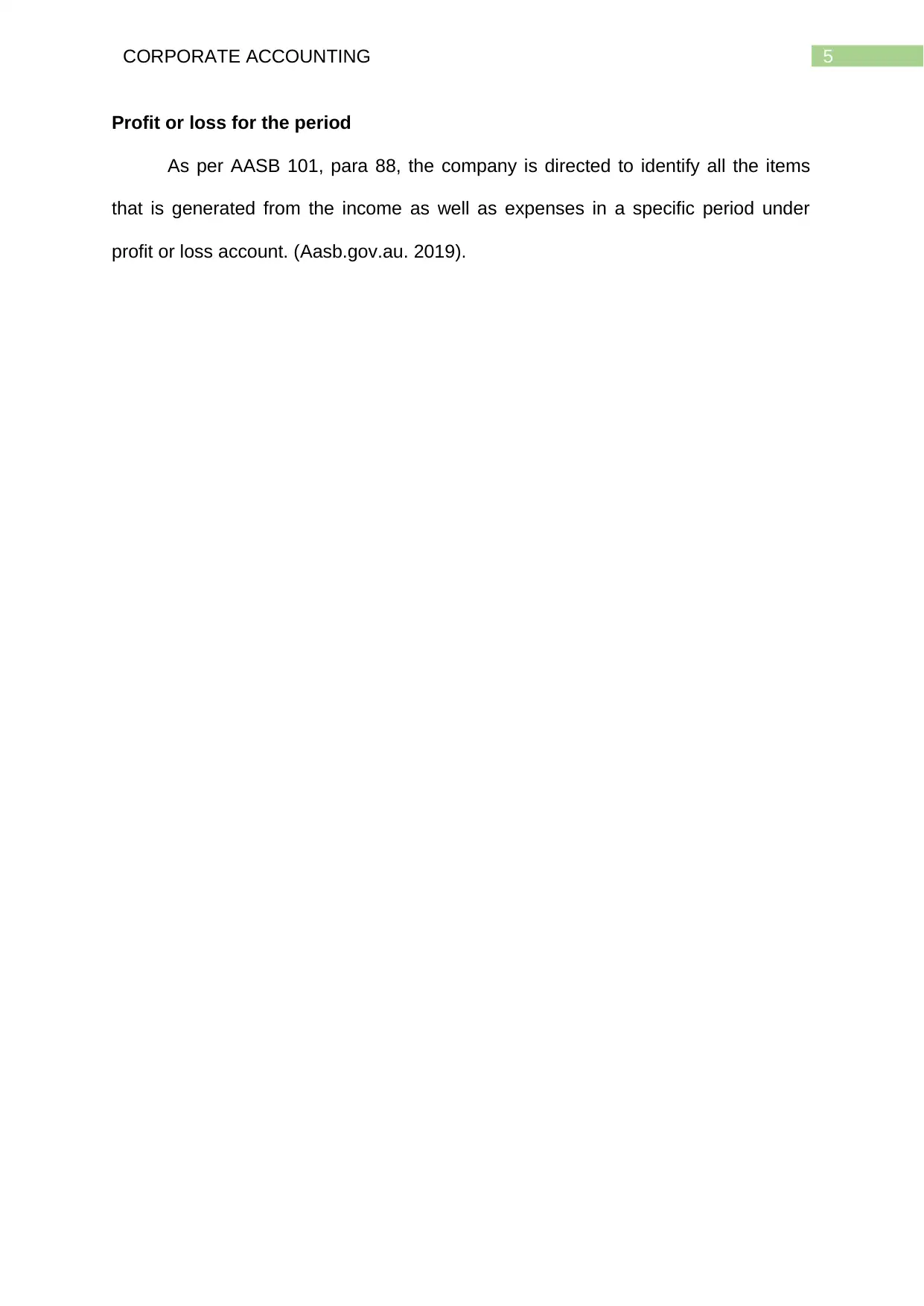
5CORPORATE ACCOUNTING
Profit or loss for the period
As per AASB 101, para 88, the company is directed to identify all the items
that is generated from the income as well as expenses in a specific period under
profit or loss account. (Aasb.gov.au. 2019).
Profit or loss for the period
As per AASB 101, para 88, the company is directed to identify all the items
that is generated from the income as well as expenses in a specific period under
profit or loss account. (Aasb.gov.au. 2019).
⊘ This is a preview!⊘
Do you want full access?
Subscribe today to unlock all pages.

Trusted by 1+ million students worldwide
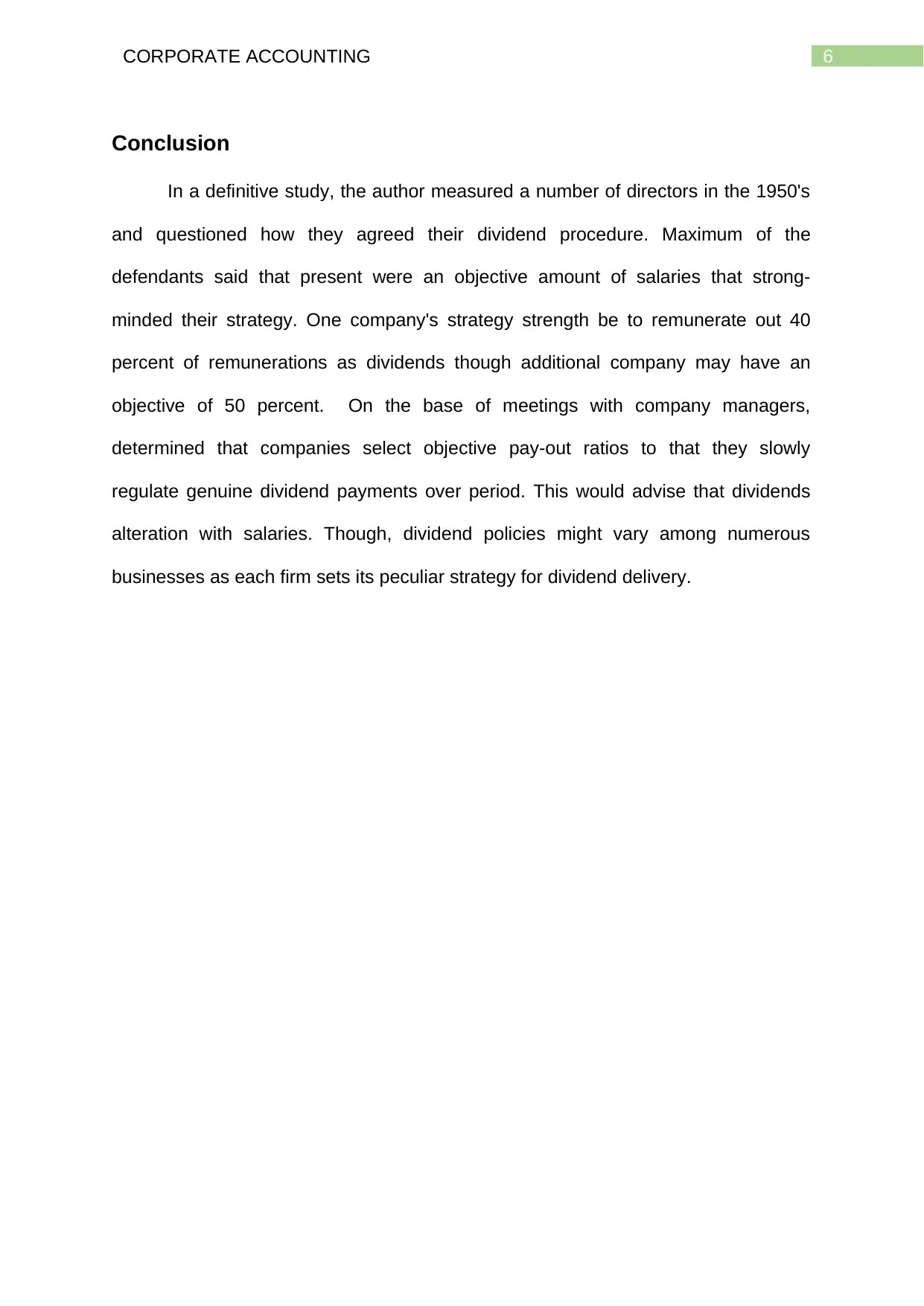
6CORPORATE ACCOUNTING
Conclusion
In a definitive study, the author measured a number of directors in the 1950's
and questioned how they agreed their dividend procedure. Maximum of the
defendants said that present were an objective amount of salaries that strong-
minded their strategy. One company's strategy strength be to remunerate out 40
percent of remunerations as dividends though additional company may have an
objective of 50 percent. On the base of meetings with company managers,
determined that companies select objective pay-out ratios to that they slowly
regulate genuine dividend payments over period. This would advise that dividends
alteration with salaries. Though, dividend policies might vary among numerous
businesses as each firm sets its peculiar strategy for dividend delivery.
Conclusion
In a definitive study, the author measured a number of directors in the 1950's
and questioned how they agreed their dividend procedure. Maximum of the
defendants said that present were an objective amount of salaries that strong-
minded their strategy. One company's strategy strength be to remunerate out 40
percent of remunerations as dividends though additional company may have an
objective of 50 percent. On the base of meetings with company managers,
determined that companies select objective pay-out ratios to that they slowly
regulate genuine dividend payments over period. This would advise that dividends
alteration with salaries. Though, dividend policies might vary among numerous
businesses as each firm sets its peculiar strategy for dividend delivery.
Paraphrase This Document
Need a fresh take? Get an instant paraphrase of this document with our AI Paraphraser
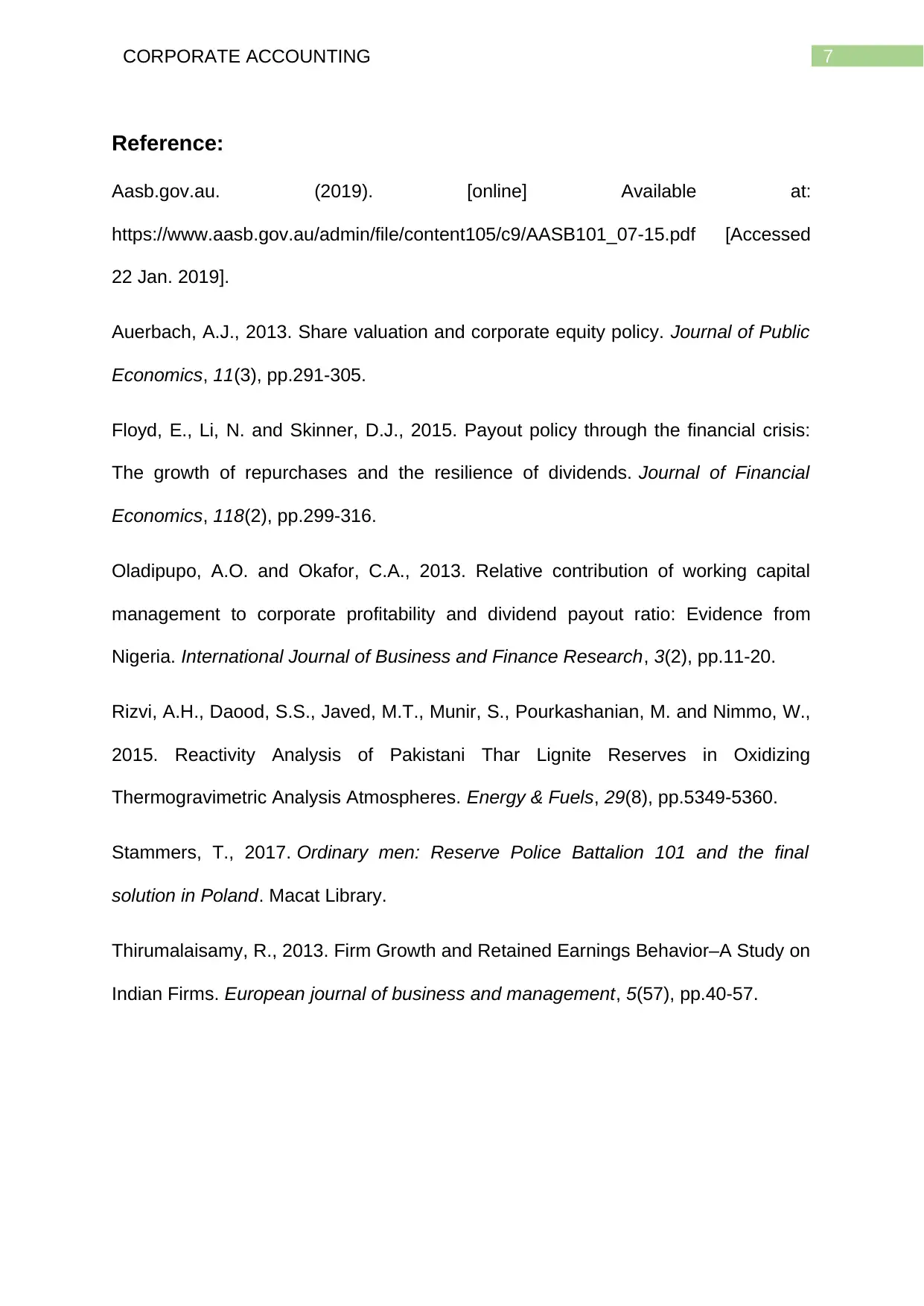
7CORPORATE ACCOUNTING
Reference:
Aasb.gov.au. (2019). [online] Available at:
https://www.aasb.gov.au/admin/file/content105/c9/AASB101_07-15.pdf [Accessed
22 Jan. 2019].
Auerbach, A.J., 2013. Share valuation and corporate equity policy. Journal of Public
Economics, 11(3), pp.291-305.
Floyd, E., Li, N. and Skinner, D.J., 2015. Payout policy through the financial crisis:
The growth of repurchases and the resilience of dividends. Journal of Financial
Economics, 118(2), pp.299-316.
Oladipupo, A.O. and Okafor, C.A., 2013. Relative contribution of working capital
management to corporate profitability and dividend payout ratio: Evidence from
Nigeria. International Journal of Business and Finance Research, 3(2), pp.11-20.
Rizvi, A.H., Daood, S.S., Javed, M.T., Munir, S., Pourkashanian, M. and Nimmo, W.,
2015. Reactivity Analysis of Pakistani Thar Lignite Reserves in Oxidizing
Thermogravimetric Analysis Atmospheres. Energy & Fuels, 29(8), pp.5349-5360.
Stammers, T., 2017. Ordinary men: Reserve Police Battalion 101 and the final
solution in Poland. Macat Library.
Thirumalaisamy, R., 2013. Firm Growth and Retained Earnings Behavior–A Study on
Indian Firms. European journal of business and management, 5(57), pp.40-57.
Reference:
Aasb.gov.au. (2019). [online] Available at:
https://www.aasb.gov.au/admin/file/content105/c9/AASB101_07-15.pdf [Accessed
22 Jan. 2019].
Auerbach, A.J., 2013. Share valuation and corporate equity policy. Journal of Public
Economics, 11(3), pp.291-305.
Floyd, E., Li, N. and Skinner, D.J., 2015. Payout policy through the financial crisis:
The growth of repurchases and the resilience of dividends. Journal of Financial
Economics, 118(2), pp.299-316.
Oladipupo, A.O. and Okafor, C.A., 2013. Relative contribution of working capital
management to corporate profitability and dividend payout ratio: Evidence from
Nigeria. International Journal of Business and Finance Research, 3(2), pp.11-20.
Rizvi, A.H., Daood, S.S., Javed, M.T., Munir, S., Pourkashanian, M. and Nimmo, W.,
2015. Reactivity Analysis of Pakistani Thar Lignite Reserves in Oxidizing
Thermogravimetric Analysis Atmospheres. Energy & Fuels, 29(8), pp.5349-5360.
Stammers, T., 2017. Ordinary men: Reserve Police Battalion 101 and the final
solution in Poland. Macat Library.
Thirumalaisamy, R., 2013. Firm Growth and Retained Earnings Behavior–A Study on
Indian Firms. European journal of business and management, 5(57), pp.40-57.
1 out of 8
Related Documents
Your All-in-One AI-Powered Toolkit for Academic Success.
+13062052269
info@desklib.com
Available 24*7 on WhatsApp / Email
![[object Object]](/_next/static/media/star-bottom.7253800d.svg)
Unlock your academic potential
Copyright © 2020–2025 A2Z Services. All Rights Reserved. Developed and managed by ZUCOL.





